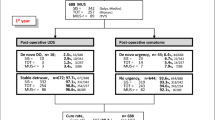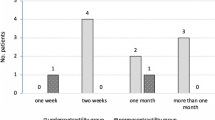Abstract
Introduction and hypothesis
There are few long-term studies on the midurethral sling (MUS) procedure in patients with preoperative detrusor overactivity (DO) and there is debate regarding the usefulness of preoperative cystometry. This study was designed to provide long-term efficacy and safety data for the Advantage MUS and to compare the outcomes in patients with pure urodynamic stress incontinence (USI) with the outcomes in patients with mixed USI and DO.
Methods
This was a retrospective consecutive case series study of 100 patients with USI (USI-only group) matched to a consecutive group of a further 100 patients with preoperative USI and DO (mixed group) treated with a retropubic MUS. Outcomes were assessed using the King’s Health Questionnaire and Patient Global Impression of Improvement questionnaire.
Results
After a mean follow up of 6 years more patients in the USI-only group described themselves as “very much better” or “much better” (86 % USI-only group vs. 57 % mixed group; p = 0.007). Quality of life was improved at 6 years from baseline in both groups. Patients in the mixed group were more likely to complain of urgency (69 % vs. 42 %; p = 0.0007) which was more likely to be severe (34 % vs. 10 %; p = 0.004). A repeat MUS procedure was needed in 1 % of patients and 0.6 % needed surgical removal of the MUS for persistent troublesome pain.
Conclusions
This study suggests that the preoperative diagnosis of DO affects the long-term patient-perceived outcome of the MUS procedure. However, most patients have significant long-term improvement in quality of life.
Similar content being viewed by others
References
Novara G, Artibani W, Barber M et al (2010) Updated systematic review and meta-analysis of the comparative data on colposuspensions, pubovaginal slings and midurethral tapes in the surgical treatment of female stress urinary incontinence. Eur Urol 58:218–238
Nilsson CG, Palva K, Aarnio R, Morcos E, Falconer C (2013) Seventeen years’ follow-up of the tension free vaginal tape procedure for female urinary stress incontinence. Int Urogynecol J 24:1265–1269
Hilton P (2008) Long-term follow-up studies in pelvic floor dysfunction: the Holy Grail or a realistic aim? BJOG 115:135–143
Duckett JR, Tamilselvi A (2006) Effect of tension-free vaginal tape in women with a urodynamic diagnosis of idiopathic detrusor overactivity and stress incontinence. BJOG 113(1):30–33
Lee JK, Dwyer PL, Rosamilia A et al (2011) Persistence of urgency and urge urinary incontinence in women with mixed urinary symptoms after midurethral slings: a multivariate analysis. BJOG 118(7):798–805
Nager CW, Brubaker L, Litman HJ (2012) A randomized trial of urodynamic testing before stress-incontinence surgery. N Engl J Med 366(21):1987–1997
Duckett JR, Patil A, Papanikolaou NS (2008) Predicting early voiding dysfunction after tension-free vaginal tape. J Obstet Gynaecol 28(1):89–92
De Boer TA, Slieker-ten Hove MCP, Burger CW, Vierhout ME (2011) The prevalence and risk factors of overactive bladder symptoms and its relation to pelvic organ prolapse symptoms in a general female population. Int Urogynecol J 22:569–575
Basu M, Duckett JR (2009) Effect of prolapse repair on voiding and the relationship to overactive bladder and detrusor overactivity? Int Urogynecol J 20:499–504
Renganathan A, Basu M, Duckett J (2011) A series of Advantage suburethral slings. J Obstet Gynaecol 31:521–523
Millard RJ, Moore K, Rencken R, Yalcin I, Bump RC (2004) Duloxetine vs placebo in the treatment of stress urinary incontinence: a four continent randomised controlled clinical trial. BJU Int 93:311–318
Kelleher CJ, Cardozo LD, Khullar V, Salvatore S (1997) A new questionnaire to assess the quality of life of urinary incontinent women. BJOG 104(12):1374–1379
Haylen BT, de Ridder D, Freeman RM et al (2010) An International Urogynecological Association (IUGA)/International Continence Society (ICS) joint report on the terminology for female pelvic floor dysfunction. Int Urogynecol J 21:5–26
Zyczynski HM, Albo ME, Goldman HB et al (2015) Change in overactive bladder symptoms after surgery for stress urinary incontinence in women. Obstet Gynecol 126:423–430
Hilton P, Robinson D (2011) Defining cure. Neurourol Urodyn 30(5):741–745
Duckett JR, Jain S (2005) Groin pain after a tension free vaginal tape or similar suburethral sling: management strategies. BJU Int 95:95–97
Fisher HW, Lotze PM (2011) Nerve injury locations during retropubic sling procedures. Int Urogynecol J 22:439–441
Ward KL, Hilton P, UK and Ireland TVT Trial Group (2008) Tension-free vaginal tape versus colposuspension for primary urodynamic stress incontinence: 5-year follow up. BJOG 115(2):226–233
Author information
Authors and Affiliations
Corresponding author
Ethics declarations
Funding
The study was partially supported by a grant from Boston Scientific, although Boston Scientific had no input into data collection or writing of the article.
Electronic supplementary material
Below is the link to the electronic supplementary material.
ESM 1
(DOCX 20 kb)
Rights and permissions
About this article
Cite this article
Balachandran, A., Duckett, J. Does the diagnosis of detrusor overactivity affect the long-term prognosis of patients treated with a retropubic midurethral sling?. Int Urogynecol J 27, 1913–1918 (2016). https://doi.org/10.1007/s00192-016-3058-9
Received:
Accepted:
Published:
Issue Date:
DOI: https://doi.org/10.1007/s00192-016-3058-9




